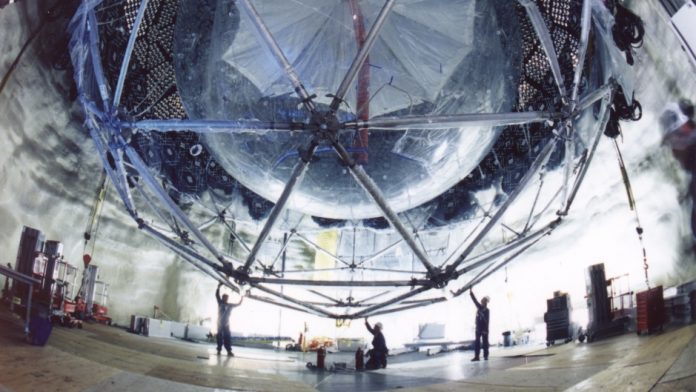There are hundreds of billions of neutrinos passing through you at this very moment, but don’t worry. These elementary particles, whose name means “little neutral one” in Italian, have no charge and so little mass, they pass through most matter unimpeded. Less than 20 years ago though, scientists were convinced that neutrinos had no mass at all.
The case of the missing neutrinos
Many of the neutrinos on Earth result from the fusion of hydrogen to helium in the Sun. This reaction produces electron neutrinos, so that’s what scientists on Earth tried to detect. The problem was, they were only detecting about one third of the number of neutrinos predicted to come from the Sun. At first, scientists thought their detection methods weren’t sensitive enough, but no matter how they measured it, the results remained the same. This was dubbed the Solar Neutrino Problem. Two other flavours of neutrinos, tau neutrinos and muon neutrinos, couldn’t be detected using the previous methods, but neutrinos were supposed to be massless, and massless particles cannot oscillate between flavours.
Enter Prof. Art McDonald
In 1990, Prof. Art McDonald became the first Director of the Sudbury Neutrino Observatory (SNO). SNO houses a sensitive neutrino detector: a 12 m diameter acrylic sphere filled with 1000 tons of ultra-pure heavy water buried 2 km underground. With such a large amount of Earth above it, only neutrinos can successfully pass into the detector, while the use of heavy water allows the detector to measure all neutrino flavours. And that made all the difference. When tau and muon neutrinos were taken into account, measurements finally matched predicted values.
Identity crisis
Somewhere between the Sun and the Earth, electron neutrinos were turning into tau or muon neutrinos. Neutrinos couldn’t be massless after all! It turns out that neutrinos do have mass, but it’s so small, we haven’t been able to measure it yet. The best we’ve been able to do is determine an upper limit of 2 eV for the mass of electron neutrinos. That’s 10,000 times less than the mass of an electron!
This discovery changed the field of particle physics, but this isn’t the first time neutrino research has resulted in a Nobel Prize. In 1995, Frederick Reine received the Nobel Prize in Physics for being the first to successfully detect a neutrino. Raymond Davis Jr. and Masatoshi Koshiba shared the 2002 prize for the first detection of solar neutrinos. For such a tiny particles, neutrinos have had a big impact.








































